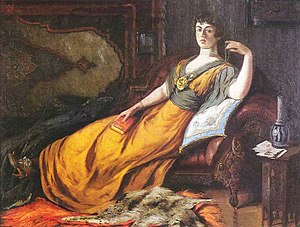
Back Bellezas circasianas Spanish زیبارویان چرکسی Persian Beauté circassienne French Para wanita Sirkasia cantik ID Bellezze circasse Italian Черкесские красавицы Russian Tjerkessiska skönheter Swedish Çerkes güzeli Turkish

| Part of a series on the |
| Circassians Адыгэхэр |
|---|
 List of notable Circassians Circassian genocide |
| Circassian diaspora |
| Circassian tribes |
|
Surviving Destroyed or barely existing |
| Religion |
|
Religion in Circassia |
| Languages and dialects |
|
| History |
|
Show |
| Culture |
The concept of Circassian beauty is an ethnic stereotype of the Circassian people. A fairly extensive literary history suggests that Circassian women were thought to be unusually beautiful and attractive, spirited, smart, and elegant. Therefore, they were seen as mentally and physically desirable for men, although most Circassians traditionally refused to marry non-Circassians in accordance with Adyghe Xabze. A smaller but similar literary history also exists for Circassian men, who were thought to be especially handsome.[1][2][3]
There are folk songs in various languages all around the Middle East and the Balkans describing the unusual beauty of Circassian women. This trend popularised greatly after the Circassian genocide, although the reputation of Circassian women dates back to the Late Middle Ages, when the Circassian coast was frequented by Italian traders from Genoa. This reputation was further reinforced by the Italian banker and politician Cosimo de' Medici (the founder of the Medici dynasty in the Republic of Florence), who conceived an illegitimate son with his Venice-based Circassian slave Maddalena. Additionally, the Circassian women who lived as slaves in the Ottoman harem, the Safavid harem, and the Qajar harem also developed a reputation as extremely beautiful, which then became a common trope of Orientalism throughout the Western world.[4]
As a result of this reputation, Circassians in Europe and Northern America were often characterised as ideals of feminine beauty in poetry and art. Consequently, from the 18th century onward, cosmetic products were often advertised by using the word "Circassian" in the title or by claiming that the product was based on substances used by women in Circassia.
Many consorts and mothers of the Ottoman Sultans were ethnic Circassians, including, but not limited to: Mahidevran Hatun, Şevkefza Sultan, Rahime Perestu Sultan, Tirimujgan Kadin, Nükhetsezâ Hanim, Hümaşah Sultan, Bedrifelek Kadin, Bidar Kadin, Kamures Kadin, Servetseza Kadin, Bezmiara Kadin, Düzdidil Hanim, Hayranidil Kadin, Meyliservet Kadin, Mihrengiz Kadin, Neşerek Kadin, Nurefsun Kadin, Reftarıdil Kadin, Şayan Kadin, Gevherriz Hanim, Ceylanyar Hanim, Dilfirib Kadin, Nalanıdil Hanim, Nergizev Hanim, and Şehsuvar Kadın. It is likely that many other concubines, whose origin is not recorded, were also of Circassian ethnicity. The "golden age" of Circassian beauty may be considered to be between the 1770s, when the Russian Empire seized the Crimean Khanate and cut off the Black Sea slave trade, which increased the demand for Circassian women in Muslim harems; and the 1860s, when the Russian Empire perpetrated the Circassian genocide and destroyed the Circassians' ancestral homeland during the Russo-Circassian War, creating the modern-day Circassian diaspora. After 1854, almost all concubines in the Ottoman harem were of Circassian origin; the Circassians had been expelled from Russian-controlled lands in the 1860s, and the impoverished refugee parents sold their daughters in a trade that was tolerated despite being formally banned.[5]
In the 1860s, the American showman P. T. Barnum exhibited women who he claimed were Circassian beauties. They had a distinctively curly style of big hair, which had no precedent in earlier portrayals of Circassians, but which was soon copied by other female performers, who became known as "moss-haired girls" in the United States. This hairstyle was a sort of exhibit's trademark and was achieved by washing the hair of women in beer, drying it, and then teasing it.[6] It is not clear why Barnum chose this hairstyle; it may have been a reference to the standard Circassian fur hat, rather than the hair.
There were also several classical Turkish music pieces and poems praising the beauty of the Circassian ethnic group, such as "Lepiska Saçlı Çerkes" (transl. "Straight, flaxen-haired Circassian"); the word "Lepiska" refers to long and blonde hair that is straight, as if it was flat-ironed.
- ^ Çelebi, Evliya. Seyahatname
- ^ Cameron, Poullet. Circassia summary
- ^ Al-Masudi's Travels
- ^ Irvin Cemil Schick, Çerkes Güzeli: Bir Şarkiyatçı İmgenin Serüveni [The Fair Circassian: Adventures of an Orientalist Motif], trans. A. Anadol (Istanbul: Oğlak Yayınları, 2004).
- ^ Brookes, Douglas Scott (2010). The Concubine, the Princess, and the Teacher: Voices from the Ottoman Harem. University of Texas Press. ISBN 978-0-292-78335-5. p. 6-8
- ^ Bogdan, Robert (2014). Race, Showmen, Disabilities and the Freak Show. NY: Routledge. pp. 200, 201. ISBN 978-0-415-74393-8.
© MMXXIII Rich X Search. We shall prevail. All rights reserved. Rich X Search